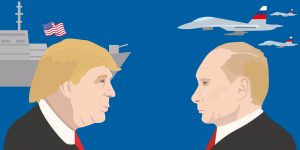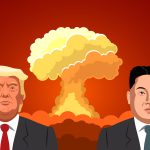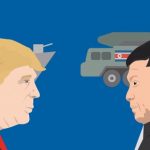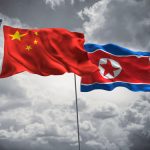The Threat of Nuclear War Looms

As US president Donald Trump landed in Japan last Saturday to begin his tour of five Asian nations, North Korea’s nuclear weapons program was a primary focus. In September, Pyongyang carried out its sixth nuclear test, which led Trump to respond with a threat to “totally destroy” North Korea.
Over the weekend, rear admiral Michael J Dumont of the US Joint Staff offered up his opinion stating that a ground war was the only way to locate and knock out Kim Jong-un’s nuclear program.
Democrat senator Dianne Feinstein said she was glad that US secretary of state Rex Tillerson was accompanying Trump on his trip, as he has the potential to achieve a diplomatic solution. “The worst alternative is a war which could become nuclear,” the senator further remarked.
US thumbs nose at solution
While many believe the threat of nuclear conflict faded with the end of the cold war, commentators insist it’s still a very real concern. MIT professor Noam Chomsky stresses the two major dangers posed by the Trump administration are its stances on climate change and nuclear weapons.
In regard to the North Korean standoff, Chomsky told Diálogos in August that a simple way out of the dispute would be for the US to accept the Chinese-backed North Korean offer to place a freeze on its nuclear weapon and missile programs.
The renowned linguist outlined that this proposal was first made two years ago, under the Obama administration. However, it seems Washington won’t accept the offer due to the North Korean requirement that the US cancel its military exercises with South Korea in exchange.
Increased US nuclear capabilities
Chomsky pointed to an article published in March in the Bulletin of the Atomic Sciences that revealed the “extremely dangerous” threat the US nuclear forces modernisation program is creating. The authors state the program is tripling the killing power of existing US ballistic missile forces.
“It creates exactly what one would expect to see, if a nuclear-armed state were planning to have the capacity to fight and win a nuclear war by disarming enemies with a surprise first strike,” the leading nuclear weapons analysts wrote.
The huge increase in US nuclear targeting capability, which has largely been concealed from the public, has serious implications when it comes to strategic stability. And it’s not relations with North Korea that are being undermined by these developments, it’s those with Russia.
A danger of the increased US nuclear capabilities is that it will appear to Russia, or China, that the US may potentially order a surprise first strike against their nations. It will raise suspicions as to US intentions, and also has the potential to reduce deterrents to using nuclear weapons.
Building tensions
Australian journalist John Pilger explained back in August that the US Congress passed a bill that is effectively waging an economic war with Russia. President Trump agreed to sign the legislation reluctantly, as he thought it was “unconstitutional.”
The bill means that the White House cannot lift any sanctions that are currently placed on Russia, North Korea or Iran. US lawmakers will now have 30 days to review any attempts by the executive to lift such sanctions.
However, the law also creates new sanctions regarding natural gas that Russia exports into European nations, such as Germany. Pilger claims the embargo is being put in place to force countries in Europe to import natural gas from the United States.
According to Pilger, this manoeuvre is provoking Russia, “the world’s second most lethal nuclear power.” Indeed, over recent years, state-controlled Russian media has been asking citizens whether they’re prepared for a coming nuclear war.
Pilger also pointed to the joint US and Australian military exercise that had just taken place. Talisman Sabre had a focus on the Malacca Straits and the South China Sea: key waterways that China uses. The admiral commanding the US Pacific fleet publicly stated that if required he would nuke China.
An end to nuclear weapons
“The contingency of using nuclear weapons has been on the table well before Trump,” Pilger told RT in April, citing the dying days of the Obama administration. “The Pentagon’s Law of War manual makes it very clear that it reserves the right to attack first with nuclear weapons.”
But, the veteran journalist emphasised that this line of thinking is at odds with the majority of humanity, and he pointed to recent developments at the United Nations as proof of this.
In July, 122 nations at a UN conference voted to adopt an international treaty to ban nuclear weapons. All countries that bear nuclear arms, along with their allies, including Australia, boycotted the negotiations over the 10 page Treaty on the Prohibition of Nuclear Weapons.
On September 20, the treaty opened for signatures at the UN headquarters in New York. The treaty will enter into force 90 days after it has been ratified by 50 nations. It’s been suggested the process could take up to two years.
International Campaign to Abolish Nuclear Weapons director Beatrice Fihn has pointed out that prohibitions on weapons of mass destruction have been effective in the past. Biological weapons were banned 45 years ago, while a prohibition on chemical weapons took effect 25 years ago.
Past UN treaties have been effective even when key nations have not been a signatory to them. The US didn’t sign the international landmines treaty. However, the nation did take the necessary steps to align with the stipulations of it.
Minutes to midnight
Of course, the US and Russia continue to be the greatest nuclear threats in the world, regardless of what is said about a nation like North Korea that is desperately trying develop weapons that in the meantime the US has aimed at them.
Today, the Russian Federation has a stockpile of around 7,000 nuclear weapons, while the US has 6,800 warheads. And the US continues to be the only nation to have used nuclear weapons during a war, when it wiped out the Japanese cities of Hiroshima and Nagasaki in August 1945.
Currently, the Bulletin of Atomic Scientists has the Doomsday Clock set to two and a half minutes to midnight. Prior to January, the minute hand had been at three minutes to midnight, which was the closest it had been since the 1980s.
“The probability of global catastrophe is very high,” the Science and Security Board warned, “and the actions needed to reduce the risks of disaster must be taken very soon.” However, with leaders like Trump at the helm, it’s a gamble as to whether the necessary actions to avert such a war will be taken.







